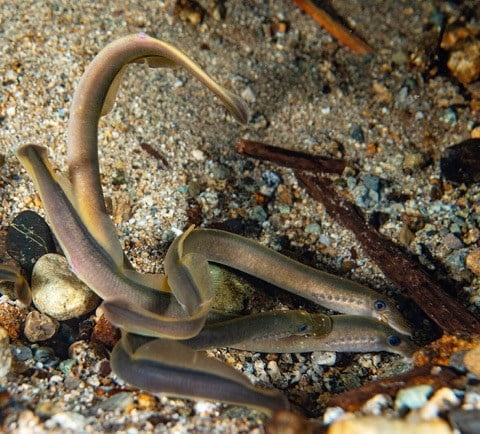SPECIES ID / Freshwater Fish of the Fraser Valley
Lamprey Family (Petromyzontidae)
Western Brook Lamprey
Kwótawi
Lampetra richardsoni
Identification Tips:
Adults
• Eel-like body (usually < 16 cm), with two dorsal fins well back on body
• No lower jaw, mouth is a round sucker with teeth inside
• Two prominent, but dull teeth visible in top of mouth
• Eyes presentLarvae (Ammocoetes)
• Long eel-like shape with no fins
• No eyes visible
• No lower jaw, mouth encased in a fleshy hood
• No teeth visible inside mouth
• Very difficult to distinguish from River Lamprey or Pacific Lamprey ammocoetes
Conservation Status:
| British Columbia | Canada | Natureserve | |
| COSEWIC | Species at Risk Act | ||
| Not at Risk (Yellow List) | Not Assessed | None | G4G5, S4 |
Information Source: BC Conservation Data Centre: http://a100.gov.bc.ca/pub/eswp/
Life History:
• Spawn in spring through mid-summer when water temperature exceeds 10 C
• Dish-shaped nest is constructed by both males and females moving gravel with mouth
• Single pair or multiple individuals may spawn together or sequentially in the nest.
• Larvae emerge at night after incubating for several weeks
• They are swept downstream into quiet areas where they burrow into mud or sand
• Filter feed in these habitats for about 4 years
• Transform into adults between August and November; adults remain in substrate until spring
• Adults do not feed; they die after spawning
Habitat:
• Spawn in gravel riffles of small streams
• Larvae found in quiet back eddies
• In first year they are in mud or silt along edges of pools
• Largest ammocoetes are in sand or leaf litter in deepest areas of pools
Range:
British Columbia
• Small streams on Vancouver Island and Fraser Valley (east to Hope)
• North to Skeena and perhaps to Stikine River
• Haida Gwaii
Global
• West of Coast MountainsCentral Oregon to northern of British Columbia
Comments:
• A textbook case of parallel evolution
• Genetic evidence shows that populations of Western Brook Lamprey from different river systems are more closely related to local populations of the the seagoing species River Lamprey than they are to one another.
• They are likely a freshwater form of River Lamprey, just like Kokanee are a freshwater form of Sockeye salmon
• Some adult Western Brook Lamprey in Morrison Creek, Courtenay BC do not spawn and die in the year they transform. They are silvery, have sharp teeth, and feed for extra year in the stream before spawning. They are listed as as endangered under Canada's Species at Risk Act.
––––––
Primary Information Source:
McPhail, J.D. 2007. The Freshwater Fishes of British Columbia. University of Alberta Press. Edmonton, Alberta.



